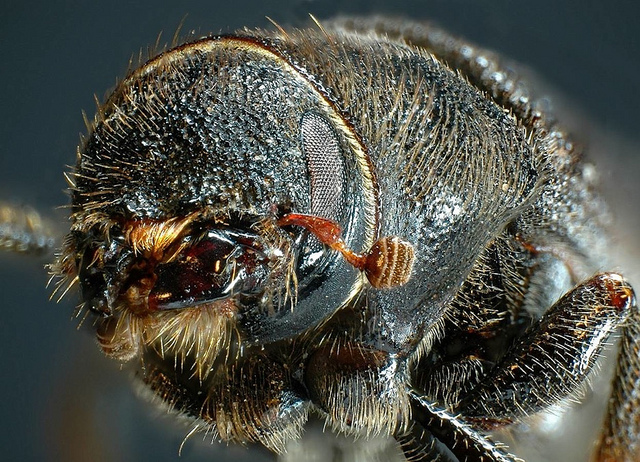The Mountain Pine Beetle: a deadly artist
The Mountain Pine Beetle kills trees and paints them blue from Mexico to Canada
JoAnna Klein • November 24, 2014

A formidable close up of the rice grain-sized mountain pine beetle. [Image credit: Flickr user Simon Fraser University]
The mountain pine beetle chews up trees and spits them out in a trail of blue wood from Mexico to Canada. In Colorado, the tiny beast is eating itself out of house and home — effectively destroying its own habitat. And as the weather warms in places the beetle used to find inhospitable, it’s on the march in mountain forests all over North America. So how does a bug the size of a grain of rice manage to kill more trees than Paul Bunyan? Simple: it does what it does, with a big push from a changing environment.
One of the most common bark beetles native to North America, the mountain pine beetle was first discovered in the Black Hills of Wyoming and South Dakota in the 1800s. In Black Elk Wilderness, which surrounds Mount Rushmore, MPBs have killed trees in every single acre of the park. They’re on a grand North American tour, reaching as far as British Columbia and Alberta, where they’re such a big problem that Tree Canada launched a “releaf” program to replace trees lost to the bug. Since a 1996 outbreak in Colorado and Wyoming, MPBs have harmed more than 4 million acres of forest, according to the U.S. Department of Agriculture Forest Service.
Scientists say with climate change, the beetles have literally reached new heights. Beetles survive longer in warmer temperatures and can move to higher elevations, north and east of their original homes. According to one study, bark beetles are likely to continue their spread throughout the western U.S. and Canada, making way for even more forest loss.
A mountain pine beetle lives for a year. After mating in the summer, the female produces about 75 eggs. She then bores into a tree, lays her eggs under the bark and dies. The larvae keep from freezing during the winter by ingesting an alcohol called glycerol. They emerge in the summer, and the cycle continues.
The first sign of an infestation is what’s known as a pitch tube. When a beetle bores into a tree’s trunk, the tree spits out resin to trap the beetle. A pitch tube resembles a wad of chewed gum, or popcorn. A red pitch tube is a result of resin mixing with pine dust. If it’s higher on the tree, say, above a person’s waist, the beetle made it in. If it’s white, then the beetle was unsuccessful. And if it’s lower on the tree, it was probably the work of a red turpentine beetle, not a killer.
In regular conditions, pine beetles pick the weakest trees to infest — the trees struggling to gather nutrients in crowded forests. Normally, they’ll infest only one or two trees per year, but when conditions are right, like during droughts, the beetles reap havoc. The beetle needn’t move fast or far to spread so rapidly. Mountain beetles fly about as fast as a human walks and about as far as half a city block. The beetles that emerge from one infestation can kill at least two trees the next year.
The beetle’s natural predators, birds and other bugs, aren’t enough to manage an infestation. But some beetles are dying off on their own — mainly because they’ve run out trees. Colorado State University has a number of suggestions for controlling and preventing infestations:
1. Spray healthy ponderosa, lodgepole and limber pines with a protective coating in the late spring before beetles fly in August.
2. Cut-down infested trees. Treat them with solar radiation and haul them a mile away. Or, throw them in the fire or bury them.
3. Keep forests thin and healthy — beetles won’t attack healthy trees.
In the meantime, designers have taken advantage of the mountain pine beetle’s characteristic blue tunnels that ultimately kill the trees. The blue color results from a fungus that clings to the beetle’s body and stains the wood as the beetle moves. While the tubes cut off vital nutrients, the fungus adds insult to injury clogging up the trees pores. Designers have used the stained wood to make tables and iPhone cases. Pest or artist, the mountain pine beetle has made its mark all over North America.